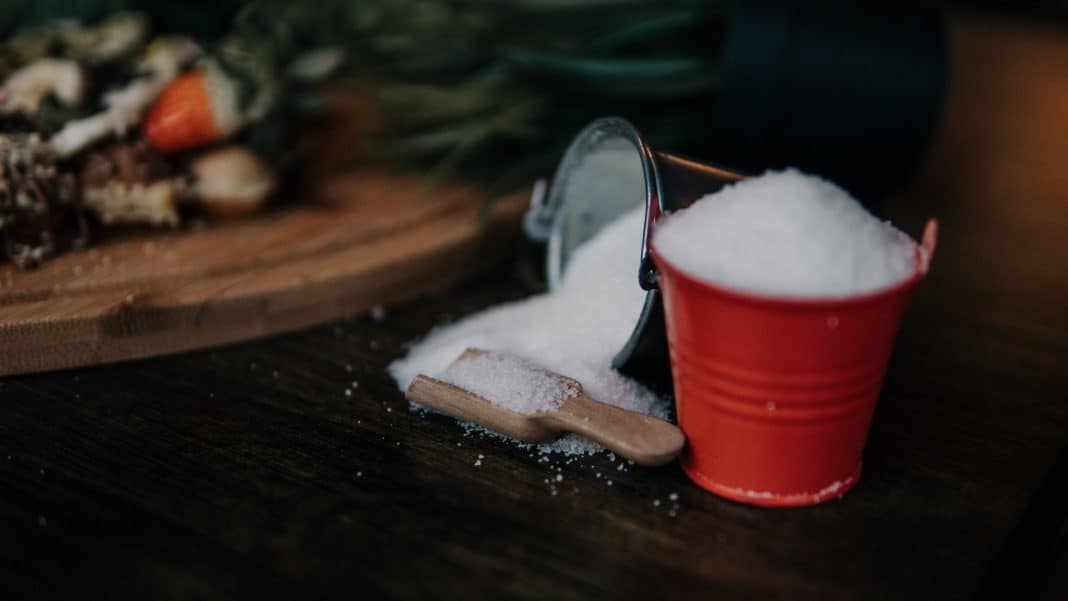Often marketed as Splenda, sucralose was approved for food manufacturers to use as a “non-nutritive sweetener” by the Food and Drug Administration (FDA) in 1999. However, rumor has it that the artificial sweetener was discovered in a lab by scientists who were trying to create a brand new pesticide. Instead they stumbled on a chemical sugar alternative that’s aggressively marketed as an option that tastes like sugar without sugar’s sweet but inherent risks.  And if you’ve been scanning the ingredients on your average box of cookies lately, you’ve probably come across the word sucralose. So is it a pesticide or a viable sugar alternative? And, more importantly, is it safe to eat something with sucralose in it or to feed it to your kids? Here’s a look at what the experts say about sucralose’s side effects and whether sucralose is safe.
And if you’ve been scanning the ingredients on your average box of cookies lately, you’ve probably come across the word sucralose. So is it a pesticide or a viable sugar alternative? And, more importantly, is it safe to eat something with sucralose in it or to feed it to your kids? Here’s a look at what the experts say about sucralose’s side effects and whether sucralose is safe.
So what is sucralose?
According to sucralose’s creators, sucralose is made by taking sugar, removing hydrogen–oxygen groups from certain places on the sucrose molecule, and putting chlorine in their place.  Splenda’s official description explains that “this change makes the sucralose molecule much sweeter than sugar, but with none of the calories.” In other words, sucralose makes things taste sweet, but it doesn’t carry nearly the amount of nutrition (or calories) of more traditional sweeteners. These days, the sugar substitute can be found in everything from soda to baked goods to frozen goodies, and because it’s heat stable—meaning it stays sweet even when brought to high temperatures—sucralose is often used in home cooking, too. In fact, it’s sold on its own in most American supermarkets for use by home cooks.
Splenda’s official description explains that “this change makes the sucralose molecule much sweeter than sugar, but with none of the calories.” In other words, sucralose makes things taste sweet, but it doesn’t carry nearly the amount of nutrition (or calories) of more traditional sweeteners. These days, the sugar substitute can be found in everything from soda to baked goods to frozen goodies, and because it’s heat stable—meaning it stays sweet even when brought to high temperatures—sucralose is often used in home cooking, too. In fact, it’s sold on its own in most American supermarkets for use by home cooks.  And when it comes to flavoring beverages and treats, sucralose offers a pretty big bang for your buck. It’s 600 times sweeter than traditional sugar but contains just a small percentage of the calories sugar does, says Sandra Arevalo, director of nutrition services and community outreach at the South Bronx Health Center in New York City.
And when it comes to flavoring beverages and treats, sucralose offers a pretty big bang for your buck. It’s 600 times sweeter than traditional sugar but contains just a small percentage of the calories sugar does, says Sandra Arevalo, director of nutrition services and community outreach at the South Bronx Health Center in New York City.
The Anti-Sugar
Although it’s often dubbed a “low calorie” or “artificial” sweetener, the name sucralose can be confusing. If you took high school French, you might know that the French word for sugar is sucre—which sounds an awful lot like the root word in sucralose. And maybe you remember the original (and long since abandoned) Splenda tagline, “Made from sugar so it tastes like sugar”? So sucralose just a souped up version of sugar, right? Not exactly.  The big difference between sucralose—or any artificial sweetener—and sugar is the nutritional value, says Lorena Drago, a registered dietitian, spokesperson for the American Association of Diabetes Educators, and founder of Hispanic Foodways, an organization that creates and disseminates culturally and ethnically oriented nutrition and [linkbuilder id=”2278″ text=”diabetes”]-education materials. Sugar is what’s known as a nutritive sweetener because it has both calories and carbohydrates. One teaspoon of sugar, for example, has about 16 calories and 4 grams of carbohydrates. A typical packet of sucralose contains just 1 gram of carbs, and little to no calories, making it a non-nutritive sweetner.
The big difference between sucralose—or any artificial sweetener—and sugar is the nutritional value, says Lorena Drago, a registered dietitian, spokesperson for the American Association of Diabetes Educators, and founder of Hispanic Foodways, an organization that creates and disseminates culturally and ethnically oriented nutrition and [linkbuilder id=”2278″ text=”diabetes”]-education materials. Sugar is what’s known as a nutritive sweetener because it has both calories and carbohydrates. One teaspoon of sugar, for example, has about 16 calories and 4 grams of carbohydrates. A typical packet of sucralose contains just 1 gram of carbs, and little to no calories, making it a non-nutritive sweetner.
Why Sucralose Is Popular
The importance of the numbers and the allure of sucralose becomes extremely apparent when you look at how much sugar you’re really consuming every day. You don’t have to be dumping spoonfuls of the granulated white stuff into your coffee or sprinkling it on your cereal in the morning to be ingesting more sugar than you should.  In fact, sugars are in almost everything we eat, from pasta sauce to bread. That’s why the 2015–2020 dietary guidelines from the U.S. Department of Health and Human Services and the U.S. Department of Agriculture focus not just on “sugar” consumption, but on the “added sugar” in our diets. The guidelines recommend consuming less than 10 percent of calories per day from added sugars. For example, an adult consuming 1,800 calories daily shouldn’t be taking in more than 180 of those calories from added sugars, which means no more than 11 teaspoons per day. But those calories add up fast. A 12 ounce serving of regular (not diet) soda alone packs between 10 and 13 teaspoons.
In fact, sugars are in almost everything we eat, from pasta sauce to bread. That’s why the 2015–2020 dietary guidelines from the U.S. Department of Health and Human Services and the U.S. Department of Agriculture focus not just on “sugar” consumption, but on the “added sugar” in our diets. The guidelines recommend consuming less than 10 percent of calories per day from added sugars. For example, an adult consuming 1,800 calories daily shouldn’t be taking in more than 180 of those calories from added sugars, which means no more than 11 teaspoons per day. But those calories add up fast. A 12 ounce serving of regular (not diet) soda alone packs between 10 and 13 teaspoons.  And if you look at other guidelines, the situation seems even more grim. The American Heart Association recommends that women consume less than 6 teaspoons or 100 calories of added sugars per day. It’s guidelines like these that have made sucralose (and other sweeteners) ever more popular, coupled with a growing awareness that consuming too much sugar has been linked to everything from an increased risk of heart disease to dementia. In one survey performed in 2016, more than half of Americans admitted they’re wary of how the sugar they eat is affecting their waistlines, and 42 percent said they feel guiltier about eating sugar than they do carbs or fats. One in 10 Americans said they’ve even said farewell to sugar entirely. If you’re hoping to join the ranks of the sugar-free, sucralose may be an option, although it’s wise to speak to your doctor or dietitian before opting to make any drastic dietary change.
And if you look at other guidelines, the situation seems even more grim. The American Heart Association recommends that women consume less than 6 teaspoons or 100 calories of added sugars per day. It’s guidelines like these that have made sucralose (and other sweeteners) ever more popular, coupled with a growing awareness that consuming too much sugar has been linked to everything from an increased risk of heart disease to dementia. In one survey performed in 2016, more than half of Americans admitted they’re wary of how the sugar they eat is affecting their waistlines, and 42 percent said they feel guiltier about eating sugar than they do carbs or fats. One in 10 Americans said they’ve even said farewell to sugar entirely. If you’re hoping to join the ranks of the sugar-free, sucralose may be an option, although it’s wise to speak to your doctor or dietitian before opting to make any drastic dietary change.  And it’s important to note that doctors and healthcare providers themselves may be playing a role in the rise of sugar substitute use. “The logic behind using artificial sweeteners in place of natural sugars is that they contain little or no calories, so they will help you to manage your weight and diabetes,” explains registered dietitian Evelyn Cheng of Eative Nutrition. About 90 percent of carbohydrates we take in are converted by the body into blood glucose, which gives the body energy. Our blood glucose rises in response to the amount and type of carbs we take in. While the body has to work to process traditional sugars due to those calories and carbs, sucralose is passed through the body relatively unchanged, leaving without supplying the body with energy. By substituting artificial sweeteners in place of sugar, you not only decrease your caloric intake, but can also minimize blood glucose spikes. That’s especially important for someone with diabetes who is trying to keep their glucose level on an even keel, and it can help also dieters, especially because glucose surges are tied to feelings of hunger.
And it’s important to note that doctors and healthcare providers themselves may be playing a role in the rise of sugar substitute use. “The logic behind using artificial sweeteners in place of natural sugars is that they contain little or no calories, so they will help you to manage your weight and diabetes,” explains registered dietitian Evelyn Cheng of Eative Nutrition. About 90 percent of carbohydrates we take in are converted by the body into blood glucose, which gives the body energy. Our blood glucose rises in response to the amount and type of carbs we take in. While the body has to work to process traditional sugars due to those calories and carbs, sucralose is passed through the body relatively unchanged, leaving without supplying the body with energy. By substituting artificial sweeteners in place of sugar, you not only decrease your caloric intake, but can also minimize blood glucose spikes. That’s especially important for someone with diabetes who is trying to keep their glucose level on an even keel, and it can help also dieters, especially because glucose surges are tied to feelings of hunger.  If your glucose spikes, so does your sense that you need to eat, Arevalo explains, which can make dieting more difficult. On the other hand, the experts are quick to caution that switching out sugar for sucralose is no panacea. “Some human research shows that people who switch sugar for sucralose don’t tend to lose more weight or have lower risks of heart disease or diabetes,” says Travis King, a registered dietitian and nutrition coach from Seattle, Washington. “Just eating sucralose instead of sugar likely won’t make you healthy, and we don’t know exactly why yet but research is pointing in that direction.”
If your glucose spikes, so does your sense that you need to eat, Arevalo explains, which can make dieting more difficult. On the other hand, the experts are quick to caution that switching out sugar for sucralose is no panacea. “Some human research shows that people who switch sugar for sucralose don’t tend to lose more weight or have lower risks of heart disease or diabetes,” says Travis King, a registered dietitian and nutrition coach from Seattle, Washington. “Just eating sucralose instead of sugar likely won’t make you healthy, and we don’t know exactly why yet but research is pointing in that direction.”  One study out of Israel, for example, asserts that sucralose affects the microbiome in our gut and can actually make us hold on to fat. The study was performed on mice rather than humans, and it looked at a variety of artificial sugars, not just sucralose. So any clear ruling from the scientific community on what the research means for how we ought to eat—or whether we should avoid sucralose in favor of our microbiomes—is yet to come. Still, Drago sees one clear reason why switching to sucralose could be holding people back. “Many products that are prepared with non-nutritive sweeteners are often not nutritious and when eaten often displace nutritious alternatives,” she says. “In addition, sugar-free foods (e.g., cakes or cookies) are neither calorie- nor carbohydrate-free, as they contain flour, which will convert into blood glucose.” Apparently there really is no such thing as a guilt-free brownie!
One study out of Israel, for example, asserts that sucralose affects the microbiome in our gut and can actually make us hold on to fat. The study was performed on mice rather than humans, and it looked at a variety of artificial sugars, not just sucralose. So any clear ruling from the scientific community on what the research means for how we ought to eat—or whether we should avoid sucralose in favor of our microbiomes—is yet to come. Still, Drago sees one clear reason why switching to sucralose could be holding people back. “Many products that are prepared with non-nutritive sweeteners are often not nutritious and when eaten often displace nutritious alternatives,” she says. “In addition, sugar-free foods (e.g., cakes or cookies) are neither calorie- nor carbohydrate-free, as they contain flour, which will convert into blood glucose.” Apparently there really is no such thing as a guilt-free brownie!
What else is out there?
Sucralose may get a lot of attention, in no small part because Splenda is now a household name, but it’s not the only sugar substitute out there. Aspartame, saccharin, stevia, acesulfame potassium, advantame, and monk fruit extract are among the long list of artificial, processed, and refined sweeteners that also have FDA approval. They all ape the sweetening power of table sugar, they’re all low calorie, and they all show up in foods and drinks that can be found in your average grocery store.  What sets each apart is its unique chemical makeup and how it can be used. Aspartame, for example, is not heat stable and isn’t recommended for use in cooking. And it contains phenylalanine, an amino acid that people with phenylketonuria (PKU) can’t metabolize. Monk fruit extract, on the other hand, is one of a growing number of sugar substitutes derived from plants or fruit. Sucralose is unique in that it’s the only one in the bunch that’s branded by Splenda, and it’s the only one formed via a process patented in the ’70s to replace the sugar molecules with chlorine.
What sets each apart is its unique chemical makeup and how it can be used. Aspartame, for example, is not heat stable and isn’t recommended for use in cooking. And it contains phenylalanine, an amino acid that people with phenylketonuria (PKU) can’t metabolize. Monk fruit extract, on the other hand, is one of a growing number of sugar substitutes derived from plants or fruit. Sucralose is unique in that it’s the only one in the bunch that’s branded by Splenda, and it’s the only one formed via a process patented in the ’70s to replace the sugar molecules with chlorine.
Is sucralose safe?
Any time people find out something’s made in a lab, they’re bound to wonder whether it’s really safe to eat, and sucralose is no different, especially when words like “chlorine” are getting thrown around with “baking” and “coffee.” Isn’t chlorine the stuff that turns your hair green in the swimming pool? “Sucralose, like most non-sugar sweeteners, is somewhat controversial,” King says. “People have a hard time trusting strange chemical names.”  The chemical has been studied extensively, and opinions in the scientific community are mixed. Although some studies point to issues in the microbiomes of mice guts, the FDA has concluded that “sucralose has been extensively studied and more than 110 safety studies were reviewed by FDA in approving the use of sucralose as a general purpose sweetener for food.” Likewise, the American Cancer Society has come out in support of sucralose, noting, “There is no proof that these sweeteners, at the levels consumed in human diets, cause cancer.” As for sucralose’s chlorine component, a certain amount of chlorine is used in drinking water, and some chlorine is allowed for food use by the FDA.
The chemical has been studied extensively, and opinions in the scientific community are mixed. Although some studies point to issues in the microbiomes of mice guts, the FDA has concluded that “sucralose has been extensively studied and more than 110 safety studies were reviewed by FDA in approving the use of sucralose as a general purpose sweetener for food.” Likewise, the American Cancer Society has come out in support of sucralose, noting, “There is no proof that these sweeteners, at the levels consumed in human diets, cause cancer.” As for sucralose’s chlorine component, a certain amount of chlorine is used in drinking water, and some chlorine is allowed for food use by the FDA.  One thing to keep in mind? Just because it’s not “natural,” doesn’t mean it’s necessarily bad for you. “A lot of research shows that sucralose is fairly safe in the amounts that people usually eat it, so even though it doesn’t magically cancel out sugar, it’s fine for most people to have in moderation,” King says. “The same goes for many alternative sweeteners: Most are very highly researched and safe in normal amounts.” The FDA recommends sucralose intake be limited to 5 milligrams per kilogram of body weight or your doctor or dietitian can help you assess just how much might be right for your daily meal plan. They can also help you determine where it might be appropriate to make a substitution and when it might be smarter to stick with regular old sugar. “For example, I might put sucralose in my coffee sometimes when I’m not going to have a chance to brush my teeth, because sucralose doesn’t contribute to tooth decay, but when I bake I usually just use regular table sugar,” King notes.
One thing to keep in mind? Just because it’s not “natural,” doesn’t mean it’s necessarily bad for you. “A lot of research shows that sucralose is fairly safe in the amounts that people usually eat it, so even though it doesn’t magically cancel out sugar, it’s fine for most people to have in moderation,” King says. “The same goes for many alternative sweeteners: Most are very highly researched and safe in normal amounts.” The FDA recommends sucralose intake be limited to 5 milligrams per kilogram of body weight or your doctor or dietitian can help you assess just how much might be right for your daily meal plan. They can also help you determine where it might be appropriate to make a substitution and when it might be smarter to stick with regular old sugar. “For example, I might put sucralose in my coffee sometimes when I’m not going to have a chance to brush my teeth, because sucralose doesn’t contribute to tooth decay, but when I bake I usually just use regular table sugar,” King notes.
What to Eat if You Want to Avoid Sucralose
If you’re still not sure you’re comfortable adding sucralose to your diet, there are alternatives to curbing a sugar addiction—and not just the artificial kind.  Scientists have found that sugar has an addictive quality, so you’ll want to check in with your doctor before making any changes, but Arevalo offers up these tips for kicking your sugar habit without adding in sucralose:
Scientists have found that sugar has an addictive quality, so you’ll want to check in with your doctor before making any changes, but Arevalo offers up these tips for kicking your sugar habit without adding in sucralose:
- If you have a sweet tooth, start by cutting down on sugar slowly. If you are currently putting 4 teaspoons of sugar in a cup of coffee, for example, cut down to 3 for a couple of weeks, then cut down to 2 and eventually to 1 teaspoon.
- Eat smaller portions of sugary foods and drinks and replace them with healthier sweet alternatives such as fruits and fruit-based drinks.
- When drinking soda or juice, add lots of ice to water your beverage down. Also consider diluting juices with water.
- Try seltzers or infused waters. When drinking iced tea, opt for homemade so you can control how much, if any, sweetener goes in.



